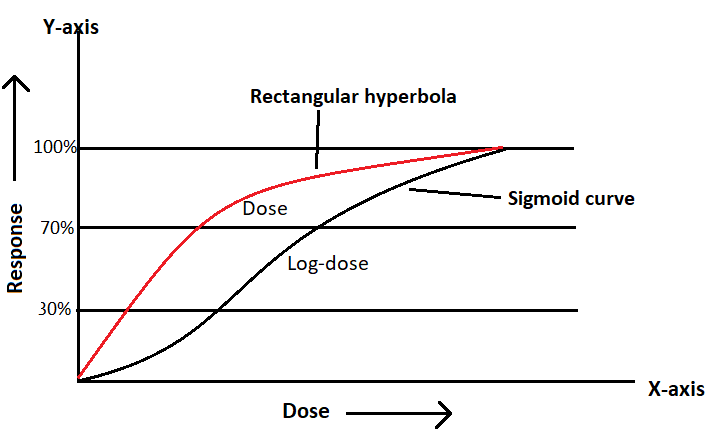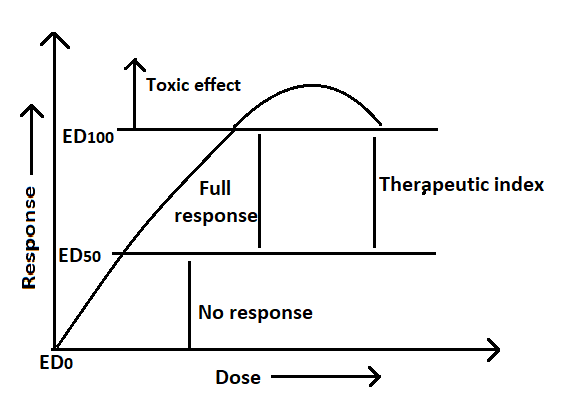Table of Contents
Dose response relationship
The response is quantitatively directly proportional to the plasma concentration as much as plasma concentration as much as the plasma concentration of drug is increase, there response will also be increase and if the drug plasma concentration is decreasing the response will also be decrease. Generally, the intensity of response increases with increases in dose and the dose-response curve of a rectangular hyperbola.
It has two components:
It is important to understand the components of dose-response relationships, as this information can be used to maximize therapeutic benefit or minimize toxicity.
1. Dose-plasma concentration relationship
When drug reaches into blood plasma, the more drug administrated systematically the more dose reached into plasma concentration. (Dose ∝ plasma membrane)
2. Plasma concentration response relationship
As much as plasma concentration of drug is increase their response will also be increased. (Plasma ∝ response)
Dose
The quantitative amount of drug which is required for produce effect in body and which is taken by a patient at a one time. In the other word, dose may be defined as the minimum amount of drug which is required for the effect in body is called dose. Example:- Dolo 650mg, Brufen 200mg
Response
Response may be defined as the all-pharmacological effect which produce after binding of the drug with receptor is called response. Generally, dose is directly proportional to response.
Dose response curve
When a graph(curve) plotted for dose response relation in which dose is plotted X-axis and response is plotted in Y-axis, is known as dose response curve or DRC. In the other word, when we plot the relationship of dose and response on to the graph then this graph is called dose response curve.
If the dose is plotted on a logarithmic scale, the curve become sigmoid and the response is seen in the intermediate (30-70% response) zone. Response is proportional to an exponential function of the dose(log-dose). In which 100% fractional change in the former case but only 10% change in the last case.
Log- dose response curve is better than dose response curve. These are some benefits:
1. A wide range of drug doses can be easily display on graph.
2. Comparison between agonist and study of antagonist become easier.
Types of Dose response curve
1. Graded curve
This type of curve is depending on the quantitative relationship as well as the dose of drug is increasing their response will also be increases, this is quantitative directly proportional relationship.
2. Quantal curve
The quantal curve is depending on the “all or none” principle. It means after taking any toxic drug either response will be 100% or response will be 0%, there is no chances of less or more.
Therapeutic index
The ratio of the dose that produce a toxic effect to the desired therapeutic effect. The therapeutic index is a measurement of the safety and effectiveness of a drug or other treatment. It is an important factor to consider when deciding which medications to prescribe for different medical conditions, as it provides information about the dosage needed for a successful and safe outcome. The therapeutic index helps doctors and other healthcare professionals determine the proper dose that should be given in order to ensure that the desired effect can be achieved without risking any adverse side effects.
The section between ED50 and ED100 of any drug in dose response curve is called therapeutic index or therapeutic curve and in therapeutic index and drug shows maximum response and less side effect.
LD-50 dose(Lither dose-50)
On which dose, the 50% of animal where killed that dose is called LD50 dose.
ED50 dose(effective dose)
In which dose the 50% of animal where curve that dose is called ED50 dose.
Combined effect of drugs
When two or more drug given in combination, then they either increase the effect of drug or they decrease the effect of drug. The combined effect of drugs can be much more powerful than the individual effects of each drug. When multiple drugs are used together, the risk for side effects is increased and the potential for therapeutic benefits is also enhanced.
Understanding how different drugs interact with each other is important for physicians and patients in order to determine which drugs should be used in combination and at what doses. This article will discuss the combined effect of medications on a person’s health, including both positive and negative effects. It will also explore some common use cases where combining certain drugs can be beneficial, as well as some potential risks that come along with it.
There are two types of effect of combination:
1. Synergistic effect
When the two different drugs are given in combination then they enhance the action of each other and the effect of drug is increase is called synergistic effect. The term “synergistic effect” refers to the combined result of two or more components working together to achieve a greater effect than either component could achieve on its own.
It is of two types:
A. Addition
When two drug given in combination then after addition their effect is increase two time. For example – paracetamol and aspirin both given in combination then it increases effect two time for analgesic and anti-pyretic effect.
B. Potentiation effect
When two drug given in a combination then they increase their effect multiple number of times, this effect is called potentiation effect. When acetylcholine and physostigmine drug are given then physostigmine drug block the effect of cholinesterase enzyme, so acetylcholine can bind with the receptor. The effect can increase multiple number of times, this is called potentiation effect.
2. Antagonist effect
When the two different drugs are given in combination then they inhibit the action of each other and the effect of drug is decrease or stop is called antagonist effect.
It is of two types:
A. Competitive antagonist
Antagonist shape is similar as agonist and bind with the same receptor and inactive receptor. Example– Anticholinergic, Antithyroid.
B. Non-competitive antagonism
When there are two different structure and shape of drug but they nullify the effect of each other they are called the non-competitive antagonism. In this type of antagonist, the other drug inactivates the receptor of organ.


